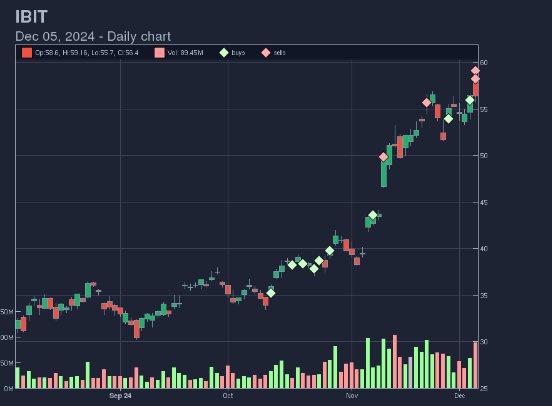2024 lessons learned
here are the things I removed from my trading in 2024, things I did really well and things I am going to work on in 2025!
First I would like to start with the things I removed from my trading this year.
Sector Strength Research
To streamline my workflow and reduce the time spent screening, I removed dedicated sector strength research from my routine.
Previously, I would run specific screeners to identify strong sectors. However, I realized this was redundant. By running daily screeners focused on gap-ups and high-volume action, I naturally develop a sense of which sectors and themes are performing well. Adding another layer of sector ETF reviews or additional screens was unnecessary and led to doing the same work twice.
This adjustment allowed me to focus more on actionable data, keeping my process efficient without sacrificing awareness of market trends.
Removing Fundamental Filters from Screeners
This year, I also eliminated the use of fundamental filters in my screeners.
Initially, I thought applying criteria like earnings growth or strong financials would help narrow down high-quality setups. However, I realized that by running daily screens for high-volume gaps, I naturally catch every earnings report or catalyst that aligns with strong fundamentals.
Essentially, the price and volume action reflect the impact of solid fundamentals without the need to pre-filter for them. This shift not only cut down on redundant screening but also ensured I didn’t miss momentum plays that might not check every box on a fundamental level but still offered strong potential.
Simplifying this part of the process allowed me to focus on what really matters – the price action and momentum driving the market each day.
Cutting Out Wide Weekend Screens
Another shift I made this year was removing the habit of running wide, expansive screens on weekends.
In the past, I’d dedicate time to casting a wide net, looking for potential plays outside my daily scans. But I realized that by consistently running quick, focused screens each day, I was already capturing the best setups in real-time. The weekend-wide screens often surfaced the same names I had already seen throughout the week.
Letting go of this process freed up valuable time – time I could spend refining tools, working on strategy, or stepping away from the market entirely to recharge. Reducing screen time without sacrificing quality setups became a key focus, and this small adjustment helped strike a better balance between trading and personal life.
Things I Did Really Well in 2024
Reflecting on this year, several key decisions and habits had a positive impact on both my trading and mindset.
Adapted to Volatility Over the Summer
I didn’t fully step away from trading during the summer but recognized the market’s heightened volatility. Instead of forcing trades, I took positions in QQQ and NVDA and let these trades work with minimal management, freeing up time to focus on personal pursuits like improving my running.
Consistent Use of a Position Size Calculator
In 2023 I made it a rule to use a position size calculator for every trade. This consistent approach kept me disciplined, improved risk management, and reduced impulsive decisions, reinforcing a structured trading process. In 2024, the incorporation of the calculator felt very natural and was easy to use.
Focused on One Day at a Time
I shifted my mindset to focus on the present, trading one day at a time instead of getting distracted by long-term market noise. This daily focus kept me grounded, lowered stress, and enhanced overall performance.
Adjusted Trade Management for Better Profit-Taking
I recognized that most of my trades hit 1R or 2R before pulling back to break-even or failing. To adjust, I took larger initial positions and scaled out sooner to lock in profits. This shift allowed me to secure gains and gave trades room to breathe if I entered a day early. Scaling back in without pressure became easier, enhancing my ability to manage trades flexibly.
Things I Need to Work on for 2025
Loosening Stops Around Support Levels
One key area I need to improve is loosening my stops when trading near support levels.
This year, I refined my understanding of how support functions. I shifted away from viewing it as a place where institutions "bounce" trades and started recognizing it as an area where they accumulate shares to improve their average cost. Often, institutions will leave bids at support without aggressively pushing the price higher.
To align with this, I need to stop taking overly tight, large positions at these levels. By being more flexible and allowing trades room to develop, I can better participate in this accumulation process—rather than getting stopped out as institutions scoop up cheaper shares.
Trading with More Size and Aggressive Add-Ons
I’ve built a system that is highly refined and efficient, allowing me to filter out 98% of the market noise. I stay consistently in tune with market leaders but often mess up and get stopped out too soon or I don’t trade them with enough size.
In 2025, I want to focus on sticking with the leaders and trading them with larger positions. My edge is strong, and scaling aggressively when the right setups present themselves will help me fully capitalize on my strategy. This is an area where I know growth will come from stepping up and trusting the system I’ve built.
Top Winners of 2024
IBIT 10/11/24 ($35.15) to 12/5/24 ($58.18)
RDDT 10/30/24 ($111.60) to 12/10/24 ($156.05)
PLTR 11/5/24 ($48.03) to 12/10/24 ($60.83)
MU 3/24/24 ($114.21) to 4/4/24 ($126.59)







